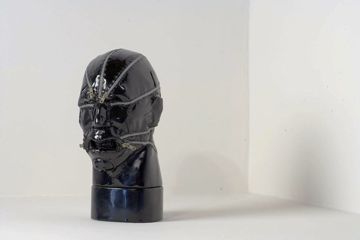On a recent trip to PS1, I had the unique opportunity to compare a few different approaches to visiting (and hopefully, seeing) exhibitions. Back in 2005 I noticed during Cai Guo Qiang’s gorgeous show, Inopportune, that people visiting the exhibit approached his work, mostly, in one of three ways. They either entered the show “cold” without reading any of the supplemental materials offered by the museum, read the material and then saw the show, or simply talked with a partner while looking at each of the works. Visiting museums across the United States since then, I often notice these three “approaches” seem to be the most popular. But is there a “best” way to view an exhibit? Does it depend on the artist, venue, or the show itself? Close colleagues and friends have weighed in on this topic and there seems to be no agreement whatsoever. Some say they read very little and see the show cold- even avoiding wall labels. Some do lots of research before committing to a show they will see. Others enjoy exhibitions most when they have someone with them to compare thoughts and ideas. So… PS1 last week offered me a rare opportunity to compare these approaches in one space since I was anxious to see three of the exhibits on display featuring Laurel Nakadate, Ryan Trecartin, and Nancy Grossman.
The first exhibit, Ryan Trecartin’s Any Ever, I entered cold. I bypassed the wall text (which I later realized was a real ball of verbal gymnastics that would have just confused me) and went straight into the first room. Not having much info to work with, I immediately fell in love with the fact that this was quite literally a video-installation. Couches were set up around the first gallery and the place looked like a living room ready for destruction- clothes on the floor, large hammers displayed on shelves. I even noticed the exact same medicine cabinet I have in my own home, which was a little creepy considering the video rolling behind me. The fact that Trecartin’s show had headsets to individually listen to the video made me compare the music happening in the room to the dialogue, if you can call it that, in the video. There was a huge difference between the relaxed music in the room to the 100 mph audio on the headsets. I stayed with this first video for almost 20 minutes before moving on and became less patient with each of the interconnected rooms I entered. The videos felt a little too similar, even though they are constructed as a series, although the installations were quite different and beautiful. I went from sitting at a picnic table to leaning on bleachers to dangling my legs from airplane seats in order to watch many of the videos. Seeing the show “cold” was initially exciting but left me a little numb by the end, and I honestly think the series of seven videos is probably impossible to see in one visit, even beyond the actual length of time it would take to see them.
The second exhibit, Laurel Nakadate’s Only the Lonely, I had read a little bit about and was excited to see for a variety of reasons. Being familiar with Nakadate’s work that “touches on voyeurism, loneliness, the manipulative power of the camera, and the urge to connect with others, through, within, and apart from technology and the media,” I felt a heck of a lot more prepared than I did for the Trecartin show. But similarly to the first exhibit, this show was impossible to see in its entirety even if I spent the entire two hours I had with this one artist. Having read about the show and being familiar with Nakadate’s photography helped me enjoy “365 Days: A Catalogue of Tears”. Certain photos in this assault of an installation drew me in to the quiet of the image. They made me guess about the authenticity of Nakadate’s “sadness” each day. Exploring sadness on this level also struck me as “performing” in way that really addressed, for example, the importance of composition in order to convey the idea vs. the way she did so with her videos. Wall texts written by the artist also helped overall, so this was an added pleasure.
Upon entering Nancy Grossman’s Heads, I was eager to try out the third approach- talking it through with someone. Since I was there alone, I decided to avail myself to the invitation on a PS1 employee’s nametag. It simply read, “Ask me.” So I did. I asked about who had the final say over the layout of the installation- Nancy Grossman or the curator. The way the space was arranged was both stunning and ominous- a symmetrical table of heads at eye level looking out at the room and four heads in each of the corners staring in. The gentleman I talked with told me that Grossman gives basic instructions about the height at which the sculptures should be viewed but that the curator designed the layout of the space. We talked about the intensity of seeing not just the front of the works at eye-level but also being able to see details on the backs of other heads while viewing each of the pieces. The detail in the stitched scraps of leather made me look again and compare how delicate details contrasted with often menacing expressions and themes, such as “the role of the silent witness amid cruelty and disorder.”
For me, going “cold” into a show is probably my last choice, with all due respect to friends and co-workers who feel passionate about this way of seeing. Creating a dialogue about what I will see and am seeing, even if it’s in my head, is often better than throwing myself at a show or a new artist. Is there a “best” way? No. Is there a best way for each of us? Probably. Discovering that way is definitely a worthwhile exercise.
